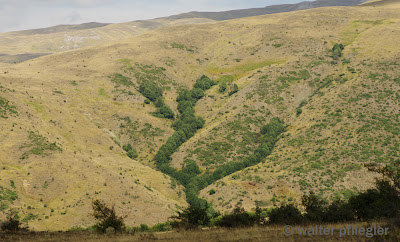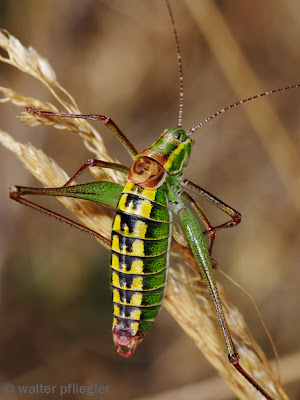The second area we visited in Albania was the Mount Gramoz (Gramos in Greek). This mountain is at the border of Albania and Greece and with its 2520 metres height, it is a prominent sight. We arrived in the late afternoon to a small village not even present on our maps: Kreshove. We camped here at 1200 m a.s.l. In the morning, we climbed up to the Gramoz and found a wonderous landscape with many interesting plants and animals.
Das zweite Gebiet das wir in Albanien besucht haben ist der Berg Gramoz (Gramos auf Griechisch). Dieser Berg liegt auf der Grenze von Albanien und Griechenland und mit einer Höhe von 2520 metern ist er eine herausragende Sicht. Wir kamen spät am Nachmittag in einem kleinen Dorf, Kreshove an: dieses Dorf war nicht einmal auf unserer Landkarte gezeigt. Wir campten hier auf 1200 m Seehöhe. In der Früh stiegen wir am Gramoz an und fanden eine wunderschöne Landschaft mit vielen interessanten Pflanzen und Tieren.
A második terület, amit Albániában meglátogattunk, a Gramoz-hegy volt (görögül Gramos). Ez a hegy az albán-görög határon található, 2520 méteres magasságával kiemelkedő látványosság. Késő délután érkeztünk meg egy apró faluba, Kreshove-ba, mely a térképünkön se volt jelölve. Itt letáboroztunk 1200 méteres magasságban. Reggel korán elindultunk felfelé a hegyen, ahol lenyűgöző tájat és rengeteg érdekes növényt és állatot találtunk.
Location/ Ort/ Helyszín: Mount Gramoz, Albania./ Berg Gramoz, Albanien./ Gramoz-hegy, Albánia. Date/ Datum/ Dátum: 12-13.09.2012.
In the night, we found some large Euscorpius italicus specimens around our camping site:
In der Nacht haben wir einige große Euscorpius italicus Examplaren neben dem Zeltplatz gefunden:
Éjszaka a sátorhely mellett néhány nagyméretű Euscorpius italicus példányt találtunk:


And also this huge wolf spider, Lycosa praegrandis:
Und auch eine sehr große Wolfspinne, Lycosa praegrandis:
És egy hatalmas farkaspókot is, a Lycosa praegrandis fajt:

On the way up:
Auf dem Weg hoch:
Úton felfelé:


We spotted some Colchicums flowering in the autumn sunshine:
Wir entdeckten einige Zeitlosen (Colchicum sp), die im herbstlichen Sonnenlicht blühten:
Találtunk pár kikericset (Colchicum sp), melyek az őszi napsütésben virágoztak:


An eryngo (Eryngium sp):
Ein Mannstreu (Eryngium sp):
Egy iringó (Eryngium sp):

The European Bushcricket (Ephippiger ephippiger):
Die Steppen-Sattelschrecke (Ephippiger ephippiger):
A nyerges szöcske (Ephippiger ephippiger):

We spotted Poecilimon bushcrickets right after their mating:
Wir fanden Buntschrecken (Poecilimon sp) gleich nachdem sie gepaart haben:
Találtunk pókszöcskéket (Poecilimon sp) éppen a párzásuk után:

The female with the attached spermatophores:
Das Weibchen mit den angehängten Spermatophoren:
A nőstény a neki átadott spermatofórákkal:

The male:
Das Männchen:
A hím:


This is a nice sheet weaver, Linyphia tenuipalpis. Probably the first record of the species from the Balkans.
Diese ist eine schöne Baldachinspinne, Linyphia tenuipalpis. Wahrscheinlich Erstfund von der Balkanhalbinsel.
Ez egy szép vitorláspók, Linyphia tenuipalpis. Valószínűleg a faj első adata a Balkánról.


We climbed up to about 1900 metres in this nice landscape:
Wir stiegen in dieser schönher Landschaft bis einer Höhe von 1900 m an:
Ezen a szép tájon másztunk fel kb. 1900 méterig:



There are many different habitats here, like subalpine meadows...
Es gibt viele verschiedene Habitats hier, wie zB. subalpine Rasen...
Számos különböző élőhelyet találni itt, mint pl. szubalpin réteket...

wet patches near streams...
nasse Fleckern neben Bächen...
tocsogós foltokat patakok mentén...

or barren rocky surfaces:
oder karge felsige Flächen:
vagy kopár, sziklás területeket:

We found small herbaceous flowers typical of the subalpine/alpine meadows:
Wir haben hier kleine krautige Pflanzen, typisch für die subalpine/alpine Wiesen, gefunden:
Apró termetű lágyszárúakat találtunk errefelé, melyek a szubalpin/alpin rétek tipikus növényei:

A plantain (Plantago cf gentianoides):
Eine Wegeriche (Plantago cf gentianoides):
Egy útifű (Plantago cf gentianoides):

There were many grasshoppers species here. This is probably Chorthippus mollis:
Es gab hier viele Heuschreckenarten. Diese ist wahrscheinlich der Verkannte Grashüpfer (Chorthippus mollis):
Számos sáskafaj volt errefelé. Ez valószínűleg a halk tarlósáska (Chorthippus mollis):

The male of the Large Banded Grasshopper (Arcyptera (Arcyptera) fusca):
Das Männchen der Großen Höckerschrecke (Arcyptera (Arcyptera) fusca):
A szép hegyisáska hímje (Arcyptera (Arcyptera) fusca):

A noctuid moth, the Hedge Rustic (Tholera cespitis):
Die Dunkelbraune Lolcheule (Tholera cespitis):
Egy bagolylepke, a sötét fésüsbagoly (Tholera cespitis):

Here, in the higher regions of the mountain, I found many spider species that I've never seen before and also some species common in Central Europe in lower landscapes. This is Alopecosa trabalis, a wolf spider:
Hier, in den höheren Regionen des Berges habe ich viele Spinnenarten gefunden, die ich zuvor noch nie gesehen habe und auch solche, die in Mitteleuropa in niedrigeren Landschaften häufig sind. Diese ist Alopecosa trabalis, eine Wolfspinne:
Itt, a hegy magasabb területein számos olyan pókot találtam, melyet még soha nem volt alkalmam megfigyelni, valamint olyan fajokat is, melyek Közép-Európában alacsonyabb tájakon gyakoriak. Ez itt egy farkaspók, Alopecosa trabalis:
A female of the Pardosa monticola group:
Ein Weibchen der Pardosa monticola Artengruppe:
Egy, a Pardosa monticola fajcsoportba tartozó nőstény:

A large Four-spot Orb-weaver (Araneus quadratus) female:
Eine riesige weibliche Vierfleckkreuzspinne (Araneus quadratus):
Egy hatalmas négyes keresztespók, nőstény (Araneus quadratus):
This nice Ladybird Spider male is Eresus kollari:
Die Rote Röhrenspinne (Eresus kollari), Männchen:
A skarlát bikapók (Eresus kollari) hímje:
Drassodes albicans, a rare gnaphosid:
Drassodes albicans, eine seltene Plattbauchspinne:
Drassodes albicans, egy ritka kövipók:

And its spotted relative, a Poecilochroa species:
Ihre gefleckte Verwandte, eine Poecilochroa-Art:
Pöttyös rokona, egy Poecilochroa-faj:
Gnaphosa petrobia is also a very rare species:
Die Gnaphosa petrobia ist auch eine sehr seltene Art:
A Gnaphosa petrobia is egy nagyon ritka faj:
Heliophanus lineiventris, a big and rare jumping spider:
Heliophanus lineiventris, eine große und seltene Springspinne:
Heliophanus lineiventris, egy nagyméretű, ritka ugrópók:
I also found a smaller Euscorpius species (maybe Euscorpius stahlavskyi) at the highest point we visited (1900 m):
Ich habe auch eine kleine Euscorpius-Art gefunden (vielleicht Euscorpius stahlavskyi), auf dem höchstem Punkt zu dem wir hochgeklettert haben (1900 m):
A legmagasabban fekvő ponton, amit meglátogattunk (1900 m), találtam egy kistestű Euscorpius-fajt (talán Euscorpius stahlavskyi):

The meadows here were swarming with Phalangium opilio harvestmen. This is a male:
Auf den Wiesen hier haben viele Hornweberknechte (Phalangium opilio) geschwärmt. Das ist der Männchen:
Az itteni réteken mindenfelé házi kaszáspókok (Phalangium opilio) mászkáltak. Ez egy hím:
Ich habe auch eine kleine Euscorpius-Art gefunden (vielleicht Euscorpius stahlavskyi), auf dem höchstem Punkt zu dem wir hochgeklettert haben (1900 m):
A legmagasabban fekvő ponton, amit meglátogattunk (1900 m), találtam egy kistestű Euscorpius-fajt (talán Euscorpius stahlavskyi):

The meadows here were swarming with Phalangium opilio harvestmen. This is a male:
Auf den Wiesen hier haben viele Hornweberknechte (Phalangium opilio) geschwärmt. Das ist der Männchen:
Az itteni réteken mindenfelé házi kaszáspókok (Phalangium opilio) mászkáltak. Ez egy hím:








A bagoly alighanem a nálunk is gyakori Tholera cespitis. (Gabor)
ReplyDeleteKöszi, beírtam!
Delete